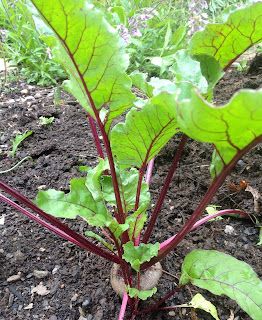On Saturday morning, before working on our own yard, we went out to the farm on Dallas Highway where we usually volunteer, and we weeded (a lot) and planted a couple dozen tomato plants and a couple dozen pepper plants in some of the raised beds.
Then, just when we thought we were leaving for the day, our farmer friend (Charles) said, "when you come back after lunch you can plant the rest of the tomatoes down in the field." So we went back after lunch, and with the help of one other guy we planted two 150 foot rows of tomato plants. In other words, we started the planting-weekend with a bang.
I didn't really start on my own yard until the next day, because I was kind of wiped out after that, but planting in my yard included:
Half of the sweet potatoes (Beauregard, Purple Delight), the parching corn (Supai Red), this year's round of the melon de-hybridization project (Amy's Kennesaw Sweet Canary), a few of the "dwarf" butternut squash that I planted last year, watermelon (Luscious Golden), cucumbers (Burpee's Picklebush, Straight Nine) to replace ones that didn't come up when they were planted before, one more tomato plant, and some flower seeds. I also started some flower seeds in Jiffy Pellets, because I will need a lot more flowers for our bees.After the corn is up and looking good, I plan to plant peanuts in the spaces between. I still have some sweet potato slips to plant (Nancy Hall, Porto Rican Gold), and I'm expecting to harvest the onions and garlic within the next two or three weeks, which means I'll be planting the Tarahumara Popping Sorghum soon, too. When the shallots come out, I'll be planting more zucchini in their space.
Joe and I also worked on the "foundation planting" area that had been destroyed last summer when the tree smashed the house. The soil there was VERY compacted clay; breaking that up and mixing in the compost and other amendments required some seriously hard work. At the sunnier end of that bed we planted the bay tree that has been growing in a pot for the past few years, three perennial, purple-flowered Salvia, and a couple of Coronation Gold Yarrow.
The hard work will all be rewarded later in the summer, when the flowers are beautiful and we are enjoying the harvest, but right now I am a mass of sore muscles. Of course, I am also very happy to have accomplished so much.
Hope all the other gardens out there are doing well!











